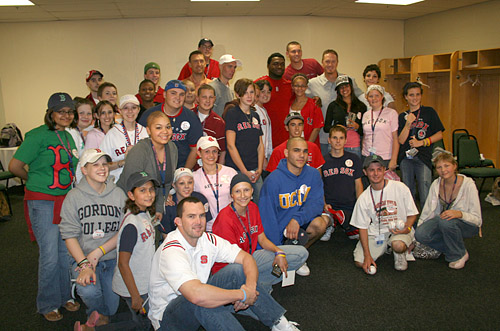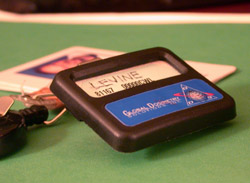Today, I had the kind of day that justifies each and every bad day I’ve had in the hospital. And because I feel like sharing my glowing mood, I’m going to do just that.
I’m currently on an outpatient rotation, which means that I spend most of my time in my clinic, seeing well children and walk-in, nonemergent sorts of things. Another thing that we do during outpatient is spend a day with one of the nurses from the Visiting Nurse Service of New York, and today was that day for me.
Now, I had been warned by some of the other residents that there aren’t pediatrics-only VNS nurses, so part of my day would also include adults (bleah); our first visit (a fortyish diabetic woman who was pregnant) bore this out, and afterwards, the nurse I was with told me that our second visit would also be an adult. This woman had recently delivered her baby via C-section, and VNS was involved only because mom’s abdominal wound was having problems fully healing. Our trip to the family took us into one of the poorest neighborhoods in New York, and likewise, into one of the more dilapidated buildings I have seen in my life. Up four flights in a tiny urine-drenched elevator, and we were there.
When we got into the apartment, mom immediately told us that she was doing very well, but that she was pretty worried about her new (16 day-old) baby. The nurse told mom that today was her “lucky day”; I, a pediatrician, happened to be along for the ride. I asked mom what she was worried about, and she told me that her son wasn’t eating very well, that he was less active than normal, and that he had a pale color — all of which can serve as red flags in a newborn. She then told me that he had been delivered at 36 weeks and that the early C-section was because mom had had preeclampsia (also red flags), and I asked to see the boy.
That’s when she handed me her newborn son, and also when I began to worry.
He was not just “less active,” he was lethargic. (Anyone in the medical field can tell you that we reserve that word — lethargic — for a very select and special class of patients. You have to be pretty sick for that particular adjective to enter the conversation.) He was mottled, yellowish-purple, didn’t seem to have all that great a respiratory effort, and his arms and legs were completely limp. I tried to stimulate him, and it didn’t do much… no crying, no major movement or increase in muscle tone, not even much eye-opening.
I quickly grabbed my stethoscope and put it on his chest, and his heart rate seemed to be pretty good — 150s to 160s (normal range for a newborn). Just as I was taking the stethoscope off, though, I heard it start to dip, and after listening for another ten seconds or so, I heard his rate go as low as 60. During this, he had no respiratory effort, but after the ten seconds, he started to breathe deeply again, and his heart rate came right back up. Over the next two minutes, he did this a few more times, and when we took the temperature, it was 95.2.
This is about when it hit me fully that this had ceased to be a visit for mom, and turned into an emergent visit for her son — he needed to get to an emergency room, quickly.
I pulled out my cellphone and called 911, and explained that I was a pediatrician with a patient who needed an ambulance immediately. I told them short form of the story (16-day old, lethargy with apnea and bradycardia, guarded condition), and they patched me directly through to the precinct dispatcher; he reassured me that someone would be there very shortly.
Again, I remembered — we were supposed to have been visiting mom.
After hanging up, I briefly called my hospital’s pediatric ER, got the attending for the acute side on the phone, and told him what was going on, warning him that we would be coming in in a hurry. Then I asked mom how long her son had been like this, and she said that it had been since yesterday morning. That begged asking her why she had waited to say something about it, she said that she had. She had called her pediatrician when she noticed the change, and after having her take the baby’s temperature (99), he said that the baby didn’t have a fever, but that she should go to the ER if she was concerned. She did go to the ER (not at my hospital), where they examined her son, decided that “he had a cold,” and sent them home. Mom remained concerned, though, and said that she had been waiting for VNS to come so that she could talk to her about it.
This whole conversation with the ER and with mom took about two and a half minutes; I know because that’s how long the police took to arrive at the door. They told me that the ambulance was less than three minutes away, but that if I felt that we couldn’t wait, they would take me in the police car — my fear of needing oxygen or advanced resuscitation equipment prevented me from accepting that offer, though. Once the EMS paramedics got there, we put an oxygen mask on the boy and started helping him breathe with the manual ventilation bag, and he perked up a bit. Next, it was down four flights in the tiny urine-drenched elevator (this time packed with the paramedics, me, the baby, and a policeman) and into the ambulance. I spent the duration of this concentrating on (a) not dropping the baby, (b) continuing to ventilate the baby, and (c) maintaining a good seal between the baby’s face and the oxygen mask, and because of that, the paramedic literally had to sit me down in the jumpseat and harness me in. He took over the manual ventilation while I held onto the baby and the mask, and we roared off, sirens blaring.
We were supposed to have been visiting mom.
About four minutes (and two hit curbs) later, we pulled into the ambulance bay, and the attending met us at the door. There were about six other people gloved, gowned, and ready in one of the trauma bays, and the baby got swallowed into their mass. IVs were put in, EKG leads and oxygen sensors were attached, blood was drawn and urine was obtained. The baby was still markedly hypothermic (95-96 degrees), he wasn’t managing to maintain his own blood oxygenation (88-89% on room air), and he was in moderate respiratory distress. The senior resident pushed antibiotics immediately, and with that, the oxygen, and the constant stimulation, the infant looked to be improving. While waiting for some results to come back, I grabbed the parents and explained to them everything that had gone on. And while speaking with them, I realized that, for the first moment in my residency, I had the real, undeniable, concrete understanding that I had been the difference between life and death for a child.
The first labwork to come back was the arterial blood gas, telling us that the baby was acidotic (he couldn’t breathe fast enough to keep up with and expire the acid that his body was producing). A stat portable chest X-ray told us why — it looked like our little boy had pretty sizable right upper-lobe pneumonia. At the least, he was suffering solely from the respiratory symptoms of the pneumonia, but much more likely, he was septic from whatever was going on in there. I called the respiratory therapist to have him come down to set up CPAP (it’s a relatively non-invasive form of positive-pressure ventilation), and then went back to talk to the parents, updating them on what was going on.
Finally, the senior resident secured the baby a spot in the peds ICU, and I told the parents that they would be going upstairs in a few minutes. I reassured mom that she had done everything right, shook their hands, and said goodbye, but just as I was turning the corner to leave the ER, mom called me back. She seemed to be nervous, looking at her shoes and tentatively rustling a packet of papers in her hands; she finally asked if I would consider becoming their baby’s primary pediatrician.
And I was pretty much the happiest person alive.




